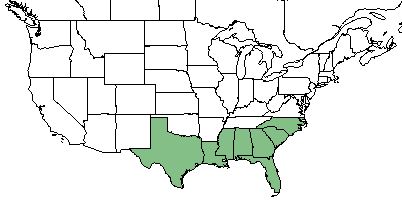Difference between revisions of "Anthaenantia villosa"
(→Distribution) |
(→Description) |
||
| Line 23: | Line 23: | ||
==Description== | ==Description== | ||
| − | ''A. villosa'' is a perennial graminoid in the Poaceae family native to the southeastern United States. <ref name= "USDA Plant Database" | + | ''A. villosa'' is a perennial graminoid in the Poaceae family native to the southeastern United States. <ref name= "USDA Plant Database"> [https://plants.usda.gov/core/profile?symbol=ANVI4 USDA Plant Database]</ref> |
<!-- Basic life history facts such as annual/perrenial, monoecious/dioecious, root morphology, seed type, etc. --> | <!-- Basic life history facts such as annual/perrenial, monoecious/dioecious, root morphology, seed type, etc. --> | ||
Revision as of 17:40, 16 May 2018
| Anthaenantia villosa | |
|---|---|
| Scientific classification | |
| Kingdom: | Plantae |
| Division: | Magnoliophyta - Flowering plants |
| Class: | Liliopsida - Monocots |
| Order: | Cyperales |
| Family: | Poaceae |
| Genus: | Anthaenantia |
| Species: | A. villosa |
| Binomial name | |
| Anthaenantia villosa (Michaux) P. Beauv. | |

| |
| Natural range of Anthaenantia villosa from USDA NRCS Plants Database. | |
Contents
Taxonomic Notes
Synonyms: Antenantia villosaKral
Variety: none
Description
A. villosa is a perennial graminoid in the Poaceae family native to the southeastern United States. [1]
Distribution
A. villosa can be found in a number of southeastern states including Florida, Georgia, Alabama, South Carolina, North Carolina, Louisiana, Mississippi, and Texas. [1]
Ecology
Habitat
A. villosa is found in long-leaf pine regions. This grass excels in more exculsively long-leaf pine regions during times of higher levels of needle fall from the canopy. [2]
Mild competition is beneficial to viable seed production for A. villosa, making the species more likely to thrive in a variety of competitive environments. [3]
Seed dispersal
A. villosa is wind-pollinated instead of reliant on insects or other animals for pollination. [2]
Use by animals
A. villosa is a bunchgrass that is used by herbivorous animals. [2]
Conservation and Management
Cultivation and restoration
Photo Gallery
References and notes
- ↑ 1.0 1.1 USDA Plant Database
- ↑ 2.0 2.1 2.2 [Brudvig, L. A., et al. (2015). "The influence of habitat fragmentation on multiple plant-animal interactions and plant reproduction." Ecology 96(10): 2669-2678]
- ↑ [Dagley, C. M., et al. (2002). "Understory restoration in longleaf pine plantations: Overstory effects of competition and needlefall." Proceedings of the eleventh biennial southern silvicultural research conference.]